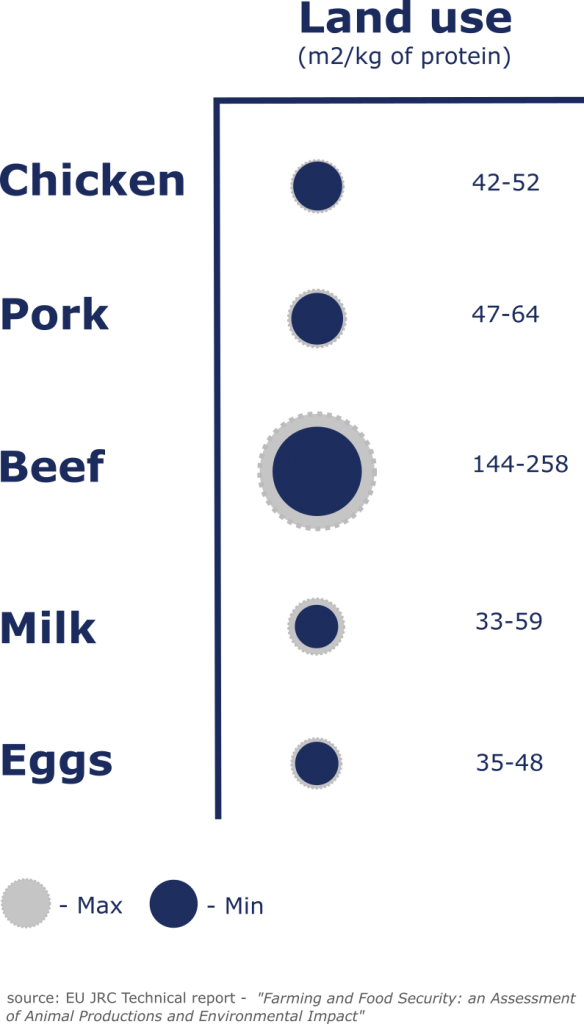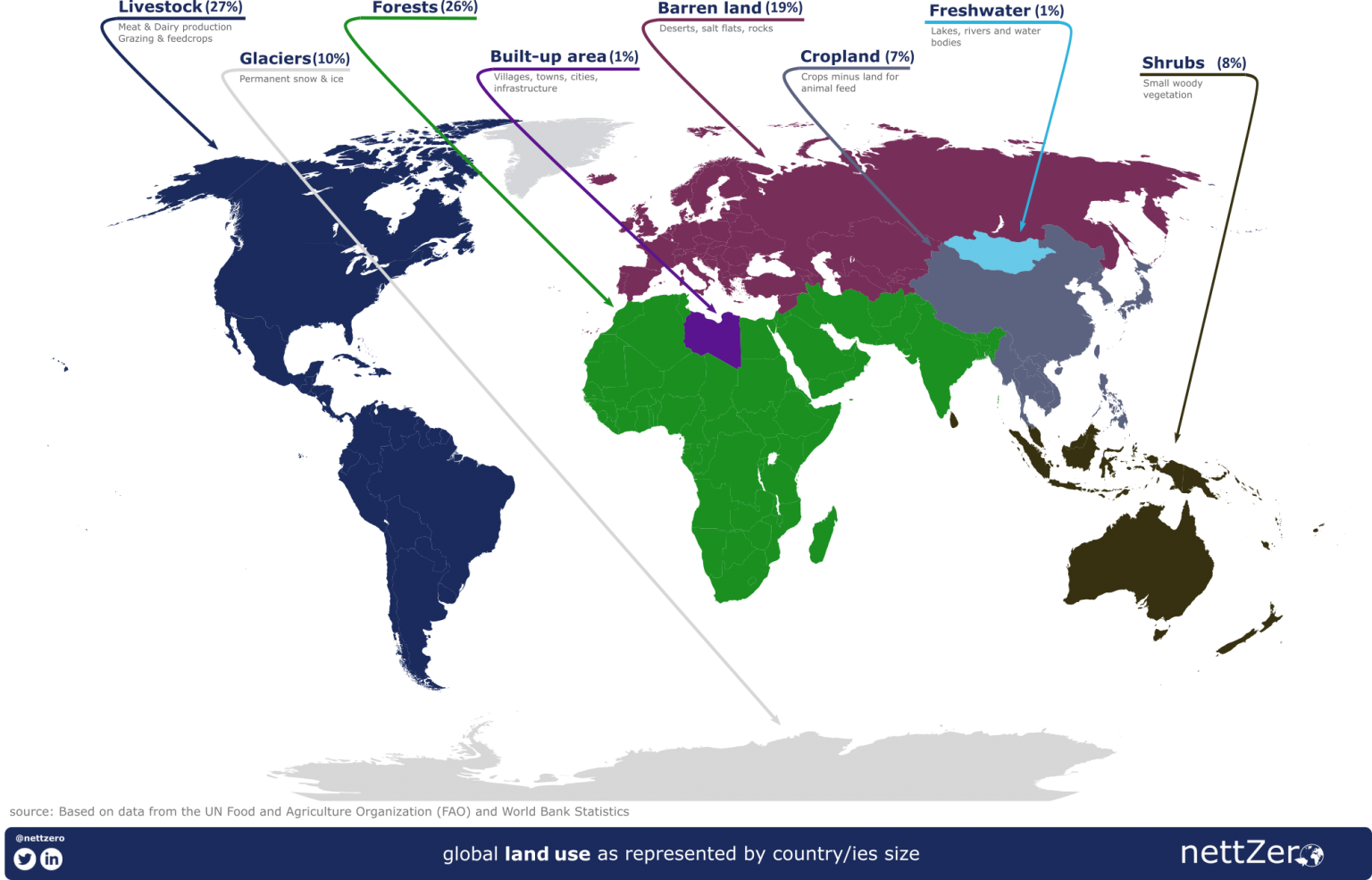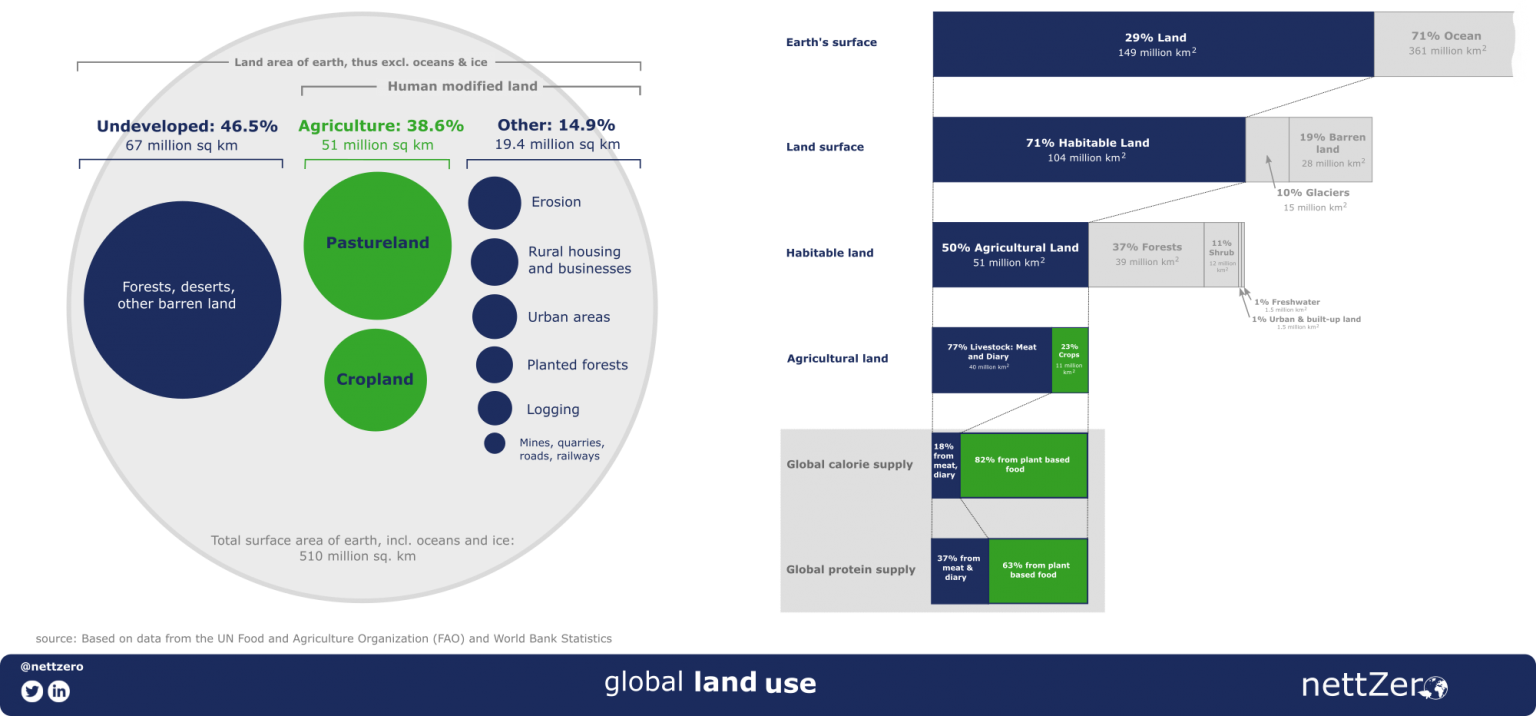Land Use and land use sustainability
When we think about threats to our environment we tend to picture industry with smokestacks and big waste and dirty water dams, not food. And although industry is a big polluter and threat to the environment, agriculture remains one of the biggest users of land. Of earths total surface area of 510 million km2, only 29% is land (the other 71% is ocean) whereas 71% of this land surface is habitable. This means that only 20% of earth’s total surface area (oceans included) is habitable. Of this 20% habitable land area, 50% is used for agriculture, which is equivalent to 34 % of the earth’s land surface (the 71% oceans excluded) and 10% of earth’s total surface (oceans included). Only about 1-4 % of the land surface is occupied by infrastructure and built-up areas, including industry and mining. Nonetheless, these built-up areas are some of the biggest polluters that affect disproportionately large areas through surface runoff, emissions and other.
For this article, however, we will only focus on the usage of land (for a pollution overview see our upcoming article on the global pollution overview).
Background to land use
There is an important difference between the transformation of land and the occupation of land. Built-up areas (infrastructure, land clearing, etc.) and crops are good examples of land transformation where the land is totally transformed by clearing and replacing the surface with infrastructure or monocultures (a single crop). Some livestock farming are examples of land occupation, which means the livestock grazes on the land without necessarily transforming it, if grazed sustainably. If grazed unsustainably (overgrazed) it can transform the land (erosion, plant species composition, etc.) and hence can turn into a land transformation. This distinction is important and are discussed below.
“Not all land use is unsustainable – Land occupation and land transformation has to be distinguished.”
a) Land occupation
According to the EU’s JRC Technical report called “Farming and Food Security: an Assessment of Animal Productions and Environmental Impact ” beef farming has the highest land use. If measured as sq. m of land use per kg of protein provided, beef uses between 144 sq. m and 258 sq. m to provide one kg of protein. Chicken, pork, milk and eggs have very similar land use intensities as these farming products’ cultivation are more concentrated in the sense that they are caged or enclosed while being fed the respective animal feeds. They don’t range when they feed but are being fed. And although cattle are also fed as they go through a feedlot before being processed, most cattle farming are more typical of a land occupation type of land use. Chicken, pork, milk and eggs are predominantly land transformation type of land use, from where they are produced to the monocultures that are cultivated to feed them. Feedlots and feeding are suited for today’s mass produce systems that are in favour of economics such as increasing output, increasing profit, etc. but are not necessarily the most sustainable. Feedlots increases animals’ food conversion compared to normal pasturing as the animals convert more of the food they eat into body mass. This is why venison meat are very low in fat compared to meat from feedlot seen that the venison meat are from full pasturing as the animals move a lot to obtain their food compared to meat from animals in feedlots where they remain largely stationary. The ideal sustainable land use would be if the world’s meat requirements can be achieved by using a sustainable land occupation type of land use, preferably full pasturing, such as with venison. Thus, of the two land uses, land occupation has the most promise for full sustainability. However, mass produce systems, where animals are control fed to maximize growth and output, are better suited to satisfy the world’s growing food requirements and the balance between pasturing and feedlots are critical to maintain or improve sustainability. The emphasis however remains on NATURAL pasturing, where animals range feed on the natural pasture as it is in its natural state and ranging it sustainably according to it’s carrying capacity.

a) Land transformation
According World Bank statistics and data from the UN Food and Agriculture Organization (FAO), the global croplands (including crops for livestock feeding) cover an area of 16.7 (+/- 2.4) million sq. km and represent about 12.8 % of earth’s land surface. When we exclude crops for livestock feeding, the crops cover an area of about 7% of earth’s land surface. This cropland (for livestock feed and human food production) is land that has been transformed and not occupied as the crops predominantly involve clearing and replacing the natural vegetation in order to cultivate the respective monoculture. Built-up areas are also land transformation as it involves land clearing and replacing the surface with infrastructure. Land transformation are one of the most destructive land use types as it totally destroys habitat. Some of the biggest threats to the earth’s remaining tropical rain forests stem from clearing (called slash and burn) to make way for farming, mining and drilling. In Malaysia and Indonesia, the forests are destructed at alarming rates to make way for palm oil, an ingredient which can be found in almost everything from shampoos to saltines. In the Amazon forests, slash and burn techniques are used to make way for livestock, which, contrary to our discussions above regarding land occupation, is a land transformation. Some figures suggest that the Amazonian deforestation from livestock represents 80% of all current deforestation. Livestock pasturing is only sustainable if it can be grazed naturally (without transforming the land) and sustainably. To slash and burn forest in order to make way for livestock is exceptionally unsustainable. Transformation of land as a land use type is one of the most destructive land use types.
Land use sustainability
a) Built-up land use (Infrastructure, etc. The built environment)
The built-up land has been know as an intensive land transformation type of land use. Although it only represents 2-4% of earth’s land surface it is known as some of the largest contributors to pollution, especially considering waste generation and emissions. Some urban areas are true “concrete jungles” with little to no green spaces. Compacting cities through reducing property size have the advantage of preventing the city expansion from damaging undisturbed land areas on the city outskirts. But green spaces also need to be created in cities and the balance between compacting cities and green space need to be cautiously approached. There is a global green cities movement that can best be described as a loose association of cities focused on sustainability, which encompasses thousands of urban areas around the world all striving to lessen their environmental impacts by reducing waste, expanding recycling, lowering emissions, increasing housing density while expanding open space, and encouraging the development of sustainable local businesses.
For mining and other ‘finite’ industries, the operations and hence the impacts are only temporary until the mining is done, which means end of life/closure can be effectively planned to ensure restoration of the land use. See our post about The Company of the Future to see more about the role of restorative circularity in creating a circular company.

b) Agricultural land use
With agriculture occupying the largest land area in the world, it’s sustainability are critical if we are to ensure we preserve the natural environment while still feeding a growing global population, which is projected to reach 9 billion by 2050.
Containing agriculture’s footprint
For most of history, we’ve simply plowed grasslands or slash and burned forests to make way for more farms. This increase in footprint has caused the loss of nearly whole ecosystems around the globe, including the prairies of North America and the Atlantic forests of Brazil. But, in order to contain current agricultural footprints while producing more to feed more people we will have to produce more with what we have. To increase production on the land that is already available, production needs to be focused on suitability. For example, if a maize crop at area x can only be produced at 3 t/ha but the land supports better grazing then rather use the land for grazing and move the maize crops to area y which is producing at 5 t/ha (without irrigation). On this premise, slashing and burning of forests to make way for livestock is incredibly unsustainable as the forest soils have very shallow nutrients layers and the cleared forest area becomes worthless in only a few years, meaning the farmers have to move on and clear more forest to support their animals. In cases such as this, meat should be produced at areas such as Argentina where livestock grazing are mostly on natural pastures and has high carrying capacities, thus high meat production per land area without transforming the land through clearing or overgrazing. Such a perfect scenario requires high level policy making and global land use planning to shift agricultural production to areas of higher yield that can support sustainable production.
Using technology and resources to increase production and yield
Some areas around the world are very suitable for high yield production but, due to lack of resources or technology, the land is not producing anywhere near its optimal yield. Africa is a good example of low yield production due to lack of resources and there is significant capacity for this continent to increase yields and fill the future global supply gaps without increasing the footprint.
Shift diets
It would be far easier to feed nine billion people by 2050 if more of the crops we grew ended up in human stomachs. Today only 55 percent of the world’s crop calories feed people directly; the rest are fed to livestock (about 36 percent) or turned into biofuels and industrial products (roughly 9 percent). Though many of us consume meat, dairy, and eggs from animals raised on feedlots, only a fraction of the calories in feed given to livestock make their way into the meat and milk that we consume. For every 100 calories of grain we feed animals, we get only about 40 new calories of milk, 22 calories of eggs, 12 of chicken, 10 of pork, or 3 of beef. Finding more efficient ways to grow meat and shifting to less meat-intensive diets—even just switching from grain-fed beef to meats like chicken, pork, or pasture-raised beef—could free up substantial amounts of food across the world. Because people in developing countries are unlikely to eat less meat in the near future, given their newfound prosperity, we can first focus on countries that already have meat-rich diets. Curtailing the use of food crops for biofuels could also go a long way toward enhancing food availability.

